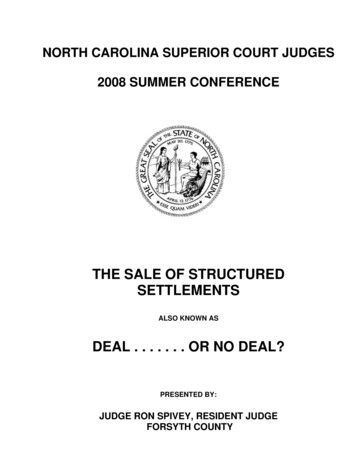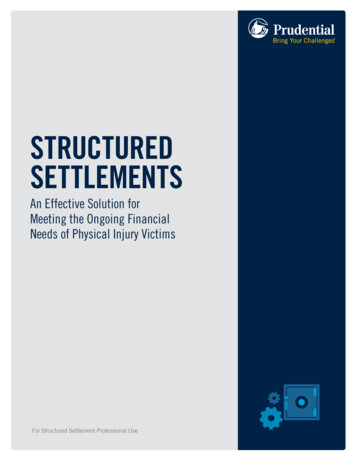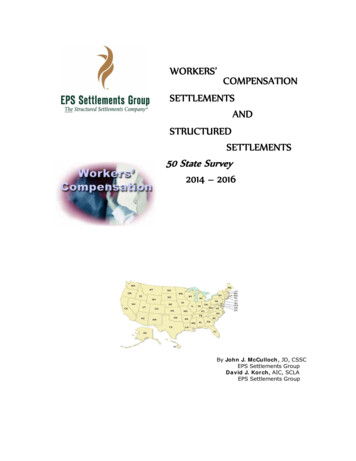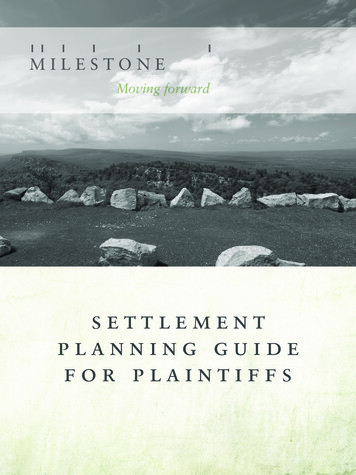
Transcription
NORTH CAROLINA SUPERIOR COURT JUDGES2008 SUMMER CONFERENCETHE SALE OF STRUCTUREDSETTLEMENTSALSO KNOWN ASDEAL . . . . . . . OR NO DEAL?PRESENTED BY:JUDGE RON SPIVEY, RESIDENT JUDGEFORSYTH COUNTY
Chapter 1 - Article 44BArticle 44B.Structured Settlement Protection Act.§ 1-543.10. Title.This Article may be cited as the North Carolina Structured Settlement Protection Act. (1999-367, s. 1.)§ 1-543.11. Definitions.For purposes of this Article:(1)"Annuity issuer" means an insurer that has issued an annuity or insurance contractused to fund periodic payments under a structured settlement;(2)"Discounted present value" means the fair present value of future payments, asdetermined by discounting such payments to the present utilizing the tables adopted inArticle 5 of Chapter 8 of the General Statutes;(3)"Independent professional advice" means advice of an attorney, certified publicaccountant, actuary, or other licensed or registered professional or financial adviser:a.Who is engaged by a payee to render advice concerning the legal, tax, andfinancial implications of a transfer of structured settlement payment rights;b.Who is not in any manner affiliated with or compensated by the transfereeof such transfer; andc.Whose compensation for rendering such advice is not affected by whether atransfer occurs or does not occur;(4)"Interested parties" means, with respect to any structured settlement, the payee,any beneficiary designated under the annuity contract to receive payments following thepayee's death, the annuity issuer, the structured settlement obligor, and any other partythat has continuing rights or obligations under the terms of the structured settlement;(5)"Payee" means an individual who is receiving tax-free damage payments under astructured settlement and proposes to make a transfer of payment rights thereunder;(6)"Qualified assignment agreement" means an agreement providing for a qualifiedassignment within the meaning of section 130 of the Internal Revenue Code, UnitedStates Code Title 26, as amended from time to time;(7)"Responsible administrative authority" means, with respect to a structuredsettlement, any government authority vested by law with exclusive jurisdiction over thesettled claim resolved by such structured settlement;(8)"Settled claim" means the original tort claim resolved by a structured settlement;(9)"Structured settlement" means an arrangement for periodic payment of damagesfor personal injuries established by settlement or judgment in resolution of a tort claim;(10) "Structured settlement agreement" means the agreement, judgment, stipulation, orrelease embodying the terms of a structured settlement, including the rights of the payeeto receive periodic payments;(11) "Structured settlement obligor" means, with respect to any structured settlement,the party that has the continuing periodic payment obligation to the payee under astructured settlement agreement or a qualified assignment agreement;(12) "Structured settlement payment rights" means rights to receive periodic payments(including lump-sum payments) under a structured settlement, whether from thefile:///C Chapter%201%20-%20Article%2044B.htm (1 of 4) [6/5/2008 2:46:34 PM]
Chapter 1 - Article 44Bsettlement obligor or the annuity issuer, where:a.The payee is domiciled in this State;b.The structured settlement agreement was approved by a court or responsibleadministrative authority in this State; orc.The settled claim was pending before the courts of this State when theparties entered into the structured settlement agreement;(13) "Terms of the structured settlement" include, with respect to any structuredsettlement, the terms of the structured settlement agreement, the annuity contract, anyqualified assignment agreement, and any order or approval of any court or responsibleadministrative authority or other government authority authorizing or approving suchstructured settlement; and(14) "Transfer" means any sale, assignment, pledge, hypothecation, or other form ofalienation or encumbrance made by a payee for consideration;(15) "Transfer agreement" means the agreement providing for transfer of structuredsettlement payment rights from a payee to a transferee. (1999-367, s. 1.)§ 1-543.12. Structured settlement payment rights.No direct or indirect transfer of structured settlement payment rights shall be effective, and no structuredsettlement obligor or annuity issuer shall be required to make any payment directly or indirectly to anytransferee of structured settlement payment rights unless the transfer has been authorized in advance in afinal order of a court of competent jurisdiction or a responsible administrative authority based on expressfindings by such court or responsible administrative authority that:(1)The transfer complies with the requirements of this Article [of] law;(2)Not less than 10 days prior to the date on which the payee first incurred anyobligation with respect to the transfer, the transferee has provided to the payee adisclosure statement in bold type, no smaller than 14 point setting forth:a.The amounts and due dates of the structured settlement payments to betransferred;b.The aggregate amount of such payments;c.The discounted present value of such payments;d.The gross amount payable to the payee in exchange for such payments;e.An itemized listing of all brokers' commissions, service charges, applicationfees, processing fees, closing costs, filing fees, administrative fees, legal fees,notary fees and other commissions, fees, costs, expenses, and charges payable bythe payee or deductible from the gross amount otherwise payable to the payee;f.The net amount payable to the payee after deduction of all commissions,fees, costs, expenses, and charges described in sub-subdivision e. of thissubdivision;g.The quotient (expressed as a percentage) obtained by dividing the netpayment amount by the discounted present value of the payments;h.The discount rate used by the transferee to determine the net amountpayable to the payee for the structured settlement payments to be transferred; andi.The amount of any penalty and the aggregate amount of any liquidateddamages (inclusive of penalties) payable by the payee in the event of any breach offile:///C Chapter%201%20-%20Article%2044B.htm (2 of 4) [6/5/2008 2:46:34 PM]
Chapter 1 - Article 44Bthe transfer agreement by the payee;(3)The transfer is in the best interest of the payee;(4)The payee has received independent professional advice regarding the legal, tax,and financial implications of the transfer;(5)The transferee has given written notice of the transferee's name, address, andtaxpayer identification number to the annuity issuer and the structured settlement obligorand has filed a copy of such notice with the court or responsible administrative authority;(6)The discount rate used in determining the net amount payable to the payee, asprovided in subdivision (2) of this section, does not exceed an annual percentage rate ofprime plus five percentage points calculated as if the net amount payable to the payee, asprovided in sub-subdivision (2)f. of this section, was the principal of a consumer loanmade by the transferee to the payee, and if the structured settlement payments to betransferred to the transferee were the payee's payments of principal plus interest on suchloan. For purposes of this subdivision, the prime rate shall be as reported by the FederalReserve Statistical Release H.15 on the first Monday of the month in which the transferagreement is signed by both the payee and the transferee, except when the transferagreement is signed prior to the first Monday of that month then the prime rate shall be asreported by the Federal Reserve Statistical Release H.15 on the first Monday of thepreceding month;(7)Any brokers' commissions, service charges, application fees, processing fees,closing costs, filing fees, administrative fees, notary fees and other commissions, fees,costs, expenses, and charges payable by the payee or deductible from the gross amountotherwise payable to the payee do not exceed two percent (2%) of the net amount payableto the payee;(8)The transfer of structured settlement payment rights is fair and reasonable; and(9)Notwithstanding a provision of the structured settlement agreement prohibiting anassignment by the payee, the court may order a transfer of periodic payment rightsprovided that the court finds that the provisions of this Article are satisfied.If the court or responsible administrative authority authorizes the transfer pursuant to this section, thecourt or responsible administrative authority shall order the structured settlement obligor to execute anacknowledgment of assignment letter on behalf of the transferee for the amount of the structuredsettlement payment rights to be transferred; provided, however, structured settlement payment rightsarising from a claim pursuant to Chapter 97 shall not be authorized. (1999-367, s. 1; 1999-456, s. 67.)§ 1-543.13. Jurisdiction.(a)Where the structured settlement agreement was entered into after commencement of litigation oradministrative proceedings in this State, the court or administrative agency where the action was pendingshall have exclusive jurisdiction over any application for authorization under this Article of a transfer ofstructured settlement payment rights.(b)Where the structured settlement agreement was entered into prior to the commencement oflitigation or administrative proceedings, or after the commencement of litigation outside this State, theSuperior Court Division of the General Court of Justice shall have nonexclusive original jurisdiction overany application for authorization under this Article of a transfer of structured settlement payment rights.(1999-367, s. 1.)file:///C Chapter%201%20-%20Article%2044B.htm (3 of 4) [6/5/2008 2:46:34 PM]
Chapter 1 - Article 44B§ 1-543.14. Procedure for approval of transfers.(a)Where the structured settlement agreement was entered into after the commencement of litigationor administrative proceedings in this State, the application for authorization of a transfer of structuredsettlement rights shall be filed with the court or administrative agency where the settled claim was pendingas a motion in the cause.(b)Where the structured settlement agreement was entered into prior to the commencement oflitigation or administrative proceedings, or after the commencement of litigation or administrativeproceedings outside this State, the application for authorization of a transfer of structured settlementpayment rights shall be filed in the superior court with proper venue pursuant to Article 7 of this Chapter.The nature of the action shall be a special proceeding governed by the provisions of Article 33 of thisChapter.(c)Not less than 30 days prior to the scheduled hearing on any application for authorization of atransfer of structured settlement payment rights under this Article, the transferee shall file with the propercourt or responsible administrative authority and serve on any other government authority whichpreviously approved the structured settlement, on all interested parties as defined in G.S. 1-543.11(4), andon the Attorney General, a notice of the proposed transfer and the application for its authorization,including in such notice:(1)A copy of the transferee's application;(2)A copy of the transfer agreement;(3)A copy of the disclosure statement required under G.S. 1-543.12(a)(2);(4)Notification that any interested party is entitled to support, oppose, or otherwiserespond to the transferee's application, either in person or by counsel, by submittingwritten comments to the court or responsible administrative authority or by participatingin the hearing; and(5)Notification of the time and place of the hearing and notification of the manner inwhich and the time by which written responses to the application must be filed in order tobe considered by the court or responsible administrative authority.(d)The Attorney General shall have standing to raise, appear, and be heard on any matter relating toan application for authorization of a transfer of structured settlement payment rights under this Article.(1999-367, s. 1.)§ 1-543.15. No waiver; penalties.(a)The provisions of this Article may not be waived.(b)Any payee who has transferred structured settlement payment rights to a transferee withoutcomplying with this Article may bring an action against the transferee to recover actual monetary loss orfor damages up to five thousand dollars ( 5,000) for the violation by the transferee, or bring actions forboth. The payee is entitled to attorneys' fees and costs incurred to enforce this Article. In addition, allunpaid structured settlement payment rights transferred in violation of this Article by any transferee shallbe reconveyed to the payee.(c)No payee who proposes to make a transfer of structured settlement payment rights shall incur anypenalty, forfeit any application fee or other payment, or otherwise incur any liability to the proposedtransferee based on any failure of such transfer to satisfy the conditions of this Article. (1999-367, s. 1.)file:///C Chapter%201%20-%20Article%2044B.htm (4 of 4) [6/5/2008 2:46:34 PM]
HYPOTHETICALS SEEKING THE TRANSFER OF ASTRUCTURED SETTLEMENT1. In 1997, Eva Gooch (then nine years old, now 20) received thebenefit of a structured settlement arising out of a wreck in which shewas injured. The minor settlement was approved late on a Fridayafternoon by Judge Clifton W. Everett, who agreed to hear the matterthen so that Eva could come to court and not miss school. Afterpayment of her medical bills, she received 15,000 which was usedto purchase an annuity, which gave her a monthly benefit after sheturned age 18 and two lump sum payments.At the time of this motion, Eva wants to sell to 321 Henderson herremaining 83 monthly payments of 265.51 per month, one lump sumpayment of 5000 on July 25th, 2014, and a final lump sum paymentof 19,553 on July 25, 2015.The aggregate of all of these payments would be 46,590.33.The discounted present value of that amount today is 36,350.44.Eva wants to sell it today for a payment of 23,928.30. 23,928.30 represents 65.80% of the estimated presentvalue of her settlement.Eva states that she wishes to sell her structured settlement to havemoney for a down payment on a home. Her mother and father areboth deceased, she just moved to town last year and is working atAcme Industries making 21 per hour plus benefits. She states thatshe is presently renting an apartment, but if she had the money for adown payment her mortgage payment would be about the same asher rental payment. She is a high school graduate with two years oftechnical education, and is taking night classes at the communitycollege. A small portion of the money may be used for this purpose.She states that she sought the advice C.P.A. David Lee who told herthat it would seem to make better financial sense to get a 95% loan
and keep getting this tax free monthly income stream from thestructured settlement. He further stated he wished he could buy itfrom her at this kind of rate. She says she’d rather have the downpayment now and a lower monthly payment in the future. She thinkshaving a mortgage interest deduction on her income tax would be agood thing in the coming years. C.P.A. Lee did not write a letter forthe court file, but she says she did pay him 200 for the office visit.She appears to understand the facts and figures of her potentialarrangement. She has no ongoing medical care and no permanentinjuries. She has no other sources of income other than her salaryand this structured settlement. The Attorney General takes noposition.2. Kim Knotts, who is almost 21 today, was injured in a car accidentwith her parents at age 5. A minor settlement was approved byJudge Ben Alford, who was assigned to this session of civil court inlieu of the Honorable Judge Narley Cashwell, who was in a holdoversession in Wake County. That settlement provided for the paymentof her medical bills, and 240 monthly payments that will commencewhen Kim reaches age 21, and her monthly payment will increase 2%every twelve months. At the time of this request, Kim wants to sell allof her 240 payments (which will start at 500 per month) to 321Henderson.The aggregate of all these payments would be 145,784.16.The discounted present value of that amount today is 93,442.00. (The discounted present value uses theapplicable federal rate of 4.5%)Kim wants to sell it today for a payment of 48,700.00.The 48,700.00 represents 52.10% of the estimatedpresent value based upon the discounted value usingthe applicable federal rate.
To get a feel for the complex nature of these transactions, animportant portion of the agreement reads as follows:The net amount payable to the seller (you) is 48,700.00. No other expenses are incurred by you.The discounted present value of payments shall be calculated as follows: The applicable federal rate usedin calculating the discounted present value is 4.50%.The effective annual discount rate for this transaction is 13.25%. The cash payment you receive in thistransaction from us was determined by applying the specified effective annual discount rate, compoundedmonthly to the total amount of future payments to be received by us, less the total amount of commissions,fees, costs, expenses and charges payable by you.The net amount that you will receive from us in exchange for your future structured settlement paymentsrepresents 52.10% of the estimated current value of the payments based upon the discounted value usingthe applicable federal rate.The quotient obtained by dividing the net payment by the discounted present value is 52.10%.Based on the net amount that you will receive from us and the amounts and timing of the structuredsettlement payments that you are turning over to us, you will, in effect, be paying interest to us at a rate of13.25% per year. The net amount paid to you (the payee) by us (the transferee) represents an estimate ofthe fair market value of the future periodic payments transferred under the structured settlement agreement.Kim tells you in support of her motion that she needs the money formedical treatment of one of her two small children, who has acondition that requires a corrective procedure. The condition is notlife threatening, but the procedure would improve the child’s quality oflife. Kim works at Walmart making minimum wage and the father ofthe child doesn’t provide any financial support. She has no othermeans to get this procedure for her child, stating that she’s soughtgovernment help but they won’t help because it’s not life threatening.Kim presently has no ongoing medical treatment of her own, but shedoes still suffer from permanent injuries that cause her to limp andshe’s often stiff at the end of each day. She consulted a localattorney who lives nearby, Jack Thompson, Esquire, who told her thatit probably wasn’t a good financial deal, but it was a life choice thatshe’d have to make. Thompson did not charge her for the advice anddid not produce a letter for the court. The Attorney General takes noposition.3. Joe was injured in a car accident at age 25 and was thebeneficiary of a settlement that resulted in the purchase of an annuityfor him. The settlement provided for the payment of his medical bills,with the remainder being placed into an annuity. The settlement wasapproved by Senior Resident Judge W. Allen Cobb, who thoroughlyand thoughtfully reviewed the settlement provisions and never
imagined that a Judge may come along several years later and undowhat he had so skillfully approved. That settlement provided that Joewould receive eight annual lump sum payments beginning on August1, 2007. Joe is attempting to sell to Symetra only 2 of his futurepayments, those being payments scheduled for August 1, 2009 and2010.The aggregate of these payments would be 37,535.00.The discounted present value of that amount today is 33,862.97.Joe wants to sell these two payments today for 29,633.87.The 29,633.87 represents 87.5% of the estimatedpresent value based upon the discounted value usingthe applicable federal rate.In this case Joe has consulted legal counsel in Greensboro,Catherine Eagles, Esquire, and is satisfied that he should go forwardwith this request. There is a letter in the file from his counsel whostates this is probably the best one of these arrangements she’s everseen. Joe says he needs this money to purchase a trailer for hispregnant bride and her two kids, who will be moving in after ashotgun wedding ceremony scheduled in early September – due datelate September. He presently rents an apartment and just startedworking 40 hours a week at Baptist Hospital in the laundry forminimum wage. The Attorney General takes no position. Joe statesthat he made a previous motion to the court when he sold his 2007annual payment in order to have a down payment on a trailer, butwhen he got the money he actually used it to pay off credit cards andget out of arrears in child support for his other two kids.
QUESTIONS THAT YOU MAY WANT TO ASK THE PAYEEState your full name and age. Are you married? Do you have children or otherdependents?What is your educational background and work experience?Do you have sources of income, other than this structured settlement?What happened to you that resulted in this structured settlement?Is there a beneficiary listed in the structured settlement agreement in the event ofyour death?Do you presently want to sell part of or all of your structured settlement proceedsto this company?Initially, did you contact them, or did they contact you?What are you attempting to sell to them?Did you receive “independent professional advice” from a licensed professionalabout these arrangements?Do you have a letter from that “independent professional” verifying thisconsultation?Did you go out and find this “independent professional” or was this personrecommended to you by the company? Who paid their fees?Did you specifically talk about the tax ramifications of selling your futurepayments to this company?Do you understand that the attorney for the company represents “the company”that is buying your structured settlement for a discounted amount, they do notrepresent you or your interests?Do you understand the total amount of the payments that you would receive overtime that you are now asking to transfer to this company? What is that amount?Do you understand the present value of the payments that you are asking totransfer, according to the company’s computations? What is that amount?Do you understand how much you would be receiving as a lump sum if I approvethis request? What is that amount?Do you know what percent of the present value this lump sum represents? Whatis that percentage?What fees are you paying to the company for this transfer?
Are you presently involved in a bankruptcy proceeding?Are you presently subject to a separation agreement or a divorce decree?Have you made a motion to the court before to transfer all of or part of yourstructured settlement?If so, what was the stated reason at that time that was the basis of your motion?If granted, did you use the proceeds for that purpose?Do you recognize Exhibit #1, the disclosure statement, which sets out all of theterms of this transfer arrangement? How long ago did you first see this?Did you read the entire exhibit? Are familiar with it?Is this your signature on the last page of the exhibit?What were your injuries that originally resulted in this structured settlement?How old were you when that happened?Do you still receive medical treatment or do you have permanent injuries fromthat accident?Why do you want to transfer your structured settlement to this company for anamount which is (much) less than you would otherwise receive over time?What will you do with the money if the court were to approve this transfer?Do you realize that if I approve this, you can’t come back later and get yourmoney back or change your mind?Do you understand that you would receive if I approve this transfertoday?Do you understand that if you didn’t transfer your structured settlement, that youwould receive over the life of the settlement as it presently exists?Do you understand that you’re only getting % of the present value ascalculated by the company?Considering all the things I’ve asked you about, do you wish to have additionaltime to think about the advisability of your request?Do you realize that if I approve this request it would end your payments pursuantto the structured settlement from this day forward (if payee is selling allpayments)?Are there any interested parties here who wish to be heard?
Transfers of Structured Settlement Payment Rights:What Judges Should Know About Structured SettlementProtection ActsBy Daniel W. Hindert and Craig H. UlmanAuthors’ Note: The authors wouldlike to acknowledge theparticipation of Jared C. Fields,an associate with Parsons Behle& Latimer, who provided researchassistance on this article.Structured settlements have enjoyedwidespread acceptance and havebecome an established part of ourlegal landscape over the past twentyfive years. More than 6 billion is nowpaid each year to fund new structuredsettlements in the United States, and anestimated 100 billion or more has beenpaid in the aggregate to fund structuredsettlements that are in force today. Littlecontroversy attended the developmentof structured settlements. Much controversy has accompanied the developmentof a secondary market, in which structured settlement “factoring” companiesacquire from settlement recipients theirrights to receive future payments.Since 1997, the controversy surrounding structured settlement factoring has led thirty-eight states to enactstatutes that make transfers of paymentrights under structured settlementsineffective unless those transfersreceive advance court approval. Since2002, the Internal Revenue Code (IRC)has reinforced the state statutes byimposing a 40 percent federal excisetax if a transfer of structured settlementpayment rights does not receive therequired court approval.Because of this unusual combination of state law requirements andfederal tax sanctions, state courtsthroughout the country are beingasked to rule on growing numbers ofapplications for approval of transfersof payment rights under state structured settlement protection acts(SSPAs). This article explains theSSPAs and their relationship to theIRC and discusses some of the keyquestions that courts need to addressin ruling on SSPA applications.Structured Settlements andthe Rise of FactoringStructured settlements are settlementsof tort claims involving physicalinjuries or physical sickness, andworkers’ compensation claims, underwhich settlement proceeds take theform of periodic payments, includingscheduled lump sum payments.Structured settlements generally arefunded by single-premium annuitycontracts held by the party that iscontractually obligated to make thefuture settlement payments.1 Underfederal tax rules designed to encourage the use of structured settlements,the full amount of each periodic payment, including the amount attributable to earnings under the annuity contract, is excludable from the settlement recipient’s income under IRCsection 104(a)(1) or (2). Congress hasendorsed use of structured settlementsas a means of assuring continuingincome to injury victims and minimizing the risk that lump sum recoveries will be dissipated, leaving victims of disabling injuries to fall backon public assistance.Consistent with the congressionalpolicy favoring use of structured settlements, and for reasons linked totheir tax treatment, structured settlement agreements typically providethat a settlement recipient’s rights toreceive future payments may not beassigned or otherwise transferred. Insome cases, transfers of paymentrights are also restricted or prohibitedunder applicable statutes or courtorders. Notwithstanding these restric-tions, an active secondary market instructured settlement payment rightsdeveloped in the early 1990s.Through aggressive advertising, specialized finance companies—nowcommonly referred to as structuredsettlement factoring companies—began persuading structured settlement recipients (referred to herein as“payees”) to trade future paymentsfor present cash.To circumvent the restrictions onassignment of payment rights, factoring companies arranged for payees toredirect their payments to factoringcompany addresses. The factoringcompanies would then collect thepayments (endorsing checks in thepayees’ names, using powers of attorney and signature stamps) withoutinforming insurers that paymentrights had been assigned.Many payees who dealt with factoring companies were exploited. Byfashioning transactions as purchasesof future payment rights or as loansoriginated in states with generoususury laws, factoring companies oftencharged sharp discounts to payeeswho were ill equipped to appreciatethe value of their future payments orto understand the onerous terms offactoring agreements. In some cases,factoring companies charged discountsequivalent to annual interest rates ashigh as 70 percent.2 Payees whodefaulted often were sued in remoteforums specified in the factoring companies’ form contracts. In many cases,these actions commenced with entry ofconfessed judgments against payees.Insurers responsible for making ostensibly nonassignable settlement payments became embroiled in collectionactions brought by factoring companies. Insurers also faced uncertain taxconsequences and risks of multipleNumber 2 Volume 44 Spring 2005 American Bar Association The Judges Journal 19“Transfers of Structured Settlement Payment Ri
The structured settlement agreement was approved by a court or responsible administrative authority in this State; or c. The settled claim was pending before the courts of this State when the parties entered into the structured settlement agreement; (13) "Terms of the structured settlement" include, with respect to any structured .










